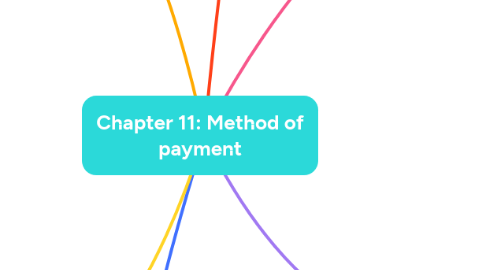
1. Cash in advance
1.1. Buyer have to pay before shipment
1.1.1. Online payment platforms( tradecard, tradebeem)
1.1.2. Fraud in document credit: prevent vertify credibility, trade terms, authenticity of documents
2. Other L/Cs
2.1. Back-to back
2.1.1. a LC is issued on strength of another LC
2.2. Transferable
2.2.1. L/C may be split among many parties, and each party is able to present their own documents for payment. but only one credit is issued
2.3. Revolving
2.3.1. Buyer can replenish the credit after seller draw
2.4. Red-clause credit
2.4.1. Advances or pre-export financing for buy goods from supplier
2.5. Green-clause credit
2.5.1. Advances can be made on presentation of warehouse receipts
2.6. Deferred-payment credit
2.6.1. Bank pay on maturity date after BL presented , no negotiable draft
2.7. Standby
2.7.1. A bank's guarantee to the beneficiary (buyer) that a specific sum of money will be received by the beneficiary in the event of default or nonperformance by the seller under a sales or service contract
3. Documents Collection
3.1. S/D,D/P
3.1.1. Buyer does not receive B/L and other documents, does not obtain possession of goods until pay to collecting bank .
3.1.2. Problems: importer's name on airway bill( not negotiable) ; not pay between the time of shipment and the draft is presented.
3.2. Document Against Acceptance
3.2.1. Time Draft: Establish the time of payment at determinable future date
3.2.2. Time draft is negotiable instrument.
3.3. Direct Collection
3.3.1. Bypass remmitting bank, send document directly to collecting bank.
3.3.2. Reduce chagre, speed.
3.4. The Uniform Rules for Collections (ICC, 1995)
3.5. Independence principle
3.5.1. The buyer or buyer's bank has no right to stop payment (under a letter of credit transaction) in order to inspect the quality of the goods
4. Documentary Letter of Credit
4.1. Bank, financial institution on behalf of buyer pay to exporter.
4.1.1. Acceptance L/C:
4.1.1.1. bank undertakes an obligation to accept draft drawn , to pay on the maturity date , negotiable tools.
4.1.2. Straight L/C
4.1.2.1. payable at issuing bank
4.2. 4 distinct bilateral contracts
4.2.1. Sales contract between buyer and seller
4.2.2. A credit and reimbursement contract between buyer and issue bank
4.2.3. Letter of credit contract between issue bank and exporter
4.2.4. Confirmed advice between advising/confirming bank and seller
4.3. To issuing bank
4.3.1. **Revocable L/C**
4.3.1.1. Between parent & subsidiary companies; can ammend or cancel credit at anytime without consent or notice to seller
4.3.2. Irrevocable L/C
4.3.2.1. cannot ammend or cancel before expiry date without consent or notice of all parties to the credit
4.4. Discrepancy
4.4.1. Accidental discrepancies
4.4.1.1. can easily corrected by exporter and issuing bank
4.4.2. Minor discrapancies
4.4.2.1. corrected by a written waiver from buyer
4.4.3. Major discrapancies
4.4.3.1. can not be corrected or only by amendment to L/C
